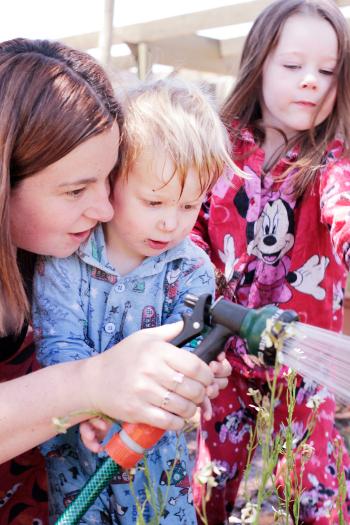Watering the garden
Duration/age

Watering the garden and pot plants is a wonderful opportunity for children to play with water and to experiment with measuring and following directions. Set up a visual schedule that shows what time of day the garden and plants will be watered. This could include a photo of a clock with the time on it or you could set a timer to sound when it is time to water the garden. Include information about which plants will be watered. Will all of the garden be watered every day or will some plants only be watered now and then?
Set up some containers of different shapes and sizes next to the tap or the hose. As you and your child fill the containers make comparisons about which is the biggest container with the greatest capacity compared to one with the smallest capacity. Try pouring water from one container to another to see if it holds the same amount. Talk about which containers are the heaviest.
Once you have filled the containers talk about which plants will require the most water.
How many buckets of water will it take before the water flows out the bottom of the pot or runs across the ground?
Think about where you will start the watering. Will you start at the very back of the yard and work towards the front? Or will you do the plants in the ground first and the pots last?
Materials you will need
- Bucket
- Water
- Hose
- Watering can
Alternative tools
- Pouring jug
Skills this activity improves
Why does this matter?
Watering the garden together provides your child with the opportunity to explore measurement and to link time and routines with daily events. As they participate in watering and filling the containers they experience different forms of language and communication that help them to follow directions related to position and location.
What does this lead to?
By watering the garden and filling differently sized and shaped containers, children are exploring the different ways that we can describe measurement. We can describe measurement through number, capacity, temperature, mass or volume. As you work together children will begin to follow direction and make decisions based on the language of measurement.
They will hear instructions informing them to add more water or that a plant may need less water compared to another plant. Using comparative language helps children to make decisions and to sort, group and classify objects. When children are able to sort, group and classify objects they are able to make predictions about how to interact with the object.
Language to use
- Season, day of the week, time of the day, yesterday, today, tomorrow
- Earlier, later
- Full, empty, more, less, same as
- Heavy, light
- Alongside, next to, between, middle, against, behind
Questions to use
- How much?
- How long?
- How heavy?
Useful tips
- Provide a variety of differently shaped and sized buckets so that you can compare the capacity of each container.
- Use containers with numbers and markings on the side.
- To prevent overwatering of plants, take photos of the plants and record the number of buckets of water each plant will require.
- Place a thermometer outside the door to help your child identify changes and increases in temperature.
- Remember to talk to your child in your home language.
More ideas
- Visit the weather bureau website to predict what the weather will be for the week.
- Create your own rainwater collection system. Set up buckets and pipes, exploring how best to catch the rain as it falls.
Variation by age
Birth to two year olds
- Set up a water play tray, adding small hand-sized containers and funnels for pouring.
- Encourage your child to help water the lawn rather than plants in small containers.
- Ask your child to help fill buckets to wash the car or the dog.
- Join together tubes and pipes and pour water through the top. Try to collect it as it runs through to the bottom.
- Build sandcastles and create a river around the outside of the sandcastle.
Three to five year olds
- Ask your child to help fill buckets to wash the car or the dog.
- Join together tubes and pipes and pour water through the top. Try to collect it as it runs through to the bottom.
- Create a pulley system to help lift the heavy buckets.
- Make your own watering system for the plants.
- Create a weather station to measure the temperature and the rainfall.
- Google different plant habitats to find out more about how to care for different plant species.
Questions to ask
- Is it full?
- Is it empty?
- How much more do you need?
- Is it up to the top?
- Where are you taking that?
Questions to ask
- Where does that plant come from?
- How often do we water that plant?
- Which plant requires more water?
- How many buckets of water does that plant need?
- Is it hotter today than yesterday?
Language to use
- Full, empty
- Top, bottom
Language to use
- Habitat
- Tropical, arid, wetland
- Drought, rainfall, flood


